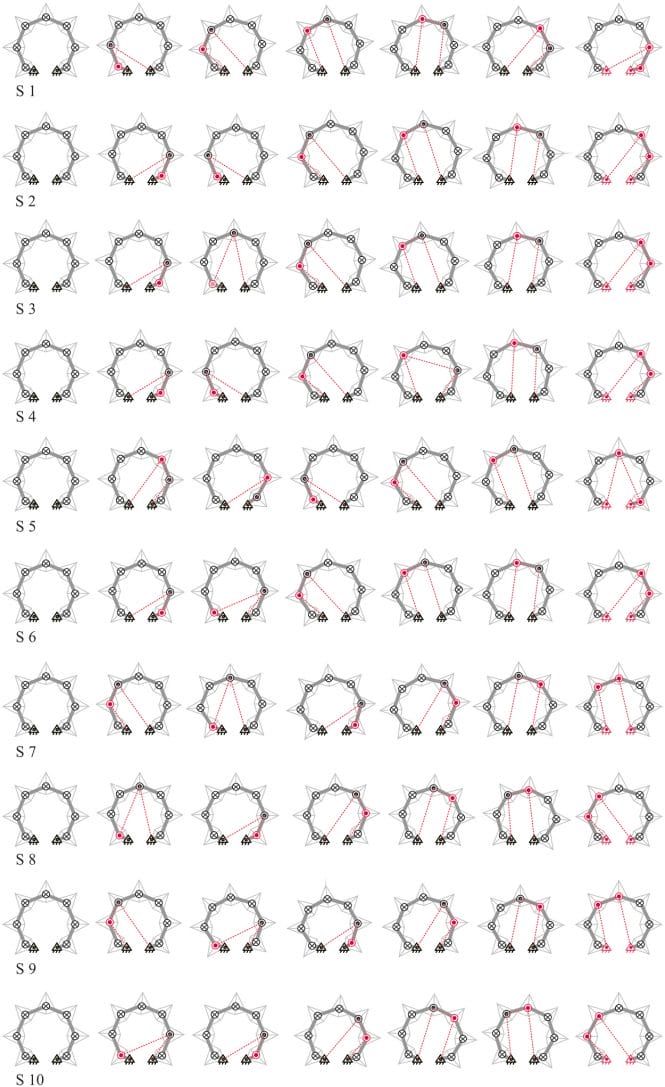Kinetic Hybrid Structures
Maria Matheou
2014 | University of Cyprus, Architecture
PhD Thesis | Supervisor: Marios K. Phokas
Κινητικές Υβριδικές Δομικές Κατασκευές
Μαρία Ματθαίου
2014 | Τμήμα Αρχιτεκτονικής Πανεπιστημίου Κύπρου
Διδακτορική Διατριβή | Επιβλέπων: Μάριος Κ. Φωκάς
ακολουθεί κείμενο στην ελληνική
The interactive relationship of society, technology and architecture has increased the demand on our built environment for optimized structures that are capable to properly respond to changing functional- and environmental conditions ([1.1], [1.2]). With regard to the dynamic stimuli response, kinetic architectural systems are characterized by adaptability, optimization and sustainability of our built-up recourses leading to buildings and building components with variable mobility, location, or geometry. Transformable and interactive structures are directly related to productivity, efficiency, effectiveness, and environmental aspects, minimum energy consumption, minimum structural self – weight, sustainable design ([1.3], [1.4]).

2. Ενεργός μηχανισμός τεσσάρων αρθρωτών ράβδων (effective 4 – bar – E4B) σε σύστημα εννιά αρθρωτών ράβδων και καλώδια ( : κλειδωμένη άρθρωση, : ελεύθερη άρθρωση, : αρθρωτές στηρίξεις εδάφους), 1: μέλος εισόδου, 2: συνδετικό μέλος, 3: μέλος εξόδου, © Μαρία Ματθαίου
The purpose of this study is to present the development of a kinetic hybrid steel prototype structure and address its static and kinematic behavior (figure 1). The innovation of the developed prototype structure is based on the dual composition of its members and the application of the effective 4-Bar method in its motion planning (figure 2). Hinge connected members, stabilized through a secondary system of struts and continuous diagonal cables with closed circuit compose the planar primary system (figure 3). A non-linear parametric static analysis is conducted through the development of structural hybrid typologies by differentiating the geometric characteristics, composition and connections. The transformability of the system is based on the application of the effective 4-Bar method using a sequence of 1-DOF motion steps and the synergetic cables’ length modification. Motion planning is conducted through simulated models and is based on structural and kinematic criteria, in order to adjust the systems’ joints to the desired values during the motion steps involved in the respective transformation sequence (figure 4, 5).
An active control system is applied that manages the operation of the motion actuators and the hydraulic linear brakes, in order to realize the reconfiguration sequences (figure 6). It includes position sensors installed on the individual joints to provide feedback information, two single motion actuators located at the structural supports, as well as hydraulic brakes installed on each strut (figure 7, 8). Specified criteria evaluate the kinetic behavior of the prototype according to the static braking torques and the axial cable forces. Following aspects of development and integration of lightweight tensile envelope systems, types of adaptable envelope structures are proposed.

4. Εφικτά μοτίβα ακολουθιών στον υπό εξέταση μηχανισμό εννιά αρθρωτών ράβδων (9 – bar) , © Μαρία Ματθαίου
ελληνικό κείμενο
Η αλληλένδετη και διαδραστική σχέση της κοινωνίας, της τεχνολογίας και της αρχιτεκτονικής, ενίσχυσε τον άξονα σχεδιασμού του δομημένου περιβάλλοντος σε βέλτιστες δομές που είναι ικανές ν’ ανταποκρίνονται σε μεταβαλλόμενες λειτουργικές και περιβαλλοντικές συνθήκες ([1.1], [1.2]). Βάσει της δυναμικής ανταπόκρισης σε ερεθίσματα, τα κινητικά αρχιτεκτονικά συστήματα χαρακτηρίζονται από προσαρμογή και βελτιστοποίηση οργανώνοντας κτίρια ή κτιριακές δομές με ευμετάβλητη κίνηση, γεωμετρία και τοποθεσία. Έναυσμα στην ενοποιημένη σχεδιαστική υλοποίηση των ευμετάβλητων και διαδραστικών δομών αποτελούν τα σύγχρονα ζητήματα για παραγωγικότητα, αποτελεσματικότητα, αποδοτικότητα, οικολογική και περιβαλλοντική συνείδηση, μείωση της ενεργειακής κατανάλωσης, του οικονομικού κόστους, της κτιριακής μάζας, αειφόρο αρχιτεκτονική κ.ο.κ. ([1.3], [1.4]).

5. Προσομοίωση βημάτων για την απαιτούμενη ρύθμιση της τελικής θέσης του μηχανισμού εννιά αρθρωτών ράβδων (9 – bar) , © Μαρία Ματθαίου
Η ερευνητική προσέγγιση επικεντρώνεται στην ανάπτυξη μιας κινητικής υβριδικής δομής εξετάζοντας τη στατική και κινητική της συμπεριφορά (εικόνα 1). Η καινοτομία της προτεινόμενης πρωτότυπης δομής βασίζεται στη δυαδική σύνθεση των μελών της και την εφαρμογή του ενεργού μηχανισμού τεσσάρων αρθρωτών ράβδων στο σχεδιασμό της κίνησης (εικόνα 2). Αρθρωτά συνδεδεμένα μέλη υποστηρίζονται από ένα δευτερεύον σύστημα ενίσχυσης ορθοστατών και συνεχόμενων καλωδίων, συνθέτοντας το επίπεδο πρωτεύον δομικό σύστημα (εικόνα 3). Μη γραμμική παραμετρική ανάλυση εδραιώνεται με βάση την ανάπτυξη υβριδικών δομικών τυπολογιών, διαφοροποιώντας τα γεωμετρικά χαρακτηριστικά, τη σύνθεση και τις συνδέσεις. Η αναδιαμόρφωση του συστήματος έγκειται στην εφαρμογή του ενεργού μηχανισμού τεσσάρων αρθρωτών ράβδων με ένα βαθμό ελευθερίας και τη συνέργεια της δυαδικής λειτουργίας των καλωδίων. Ο σχεδιασμός της κίνησης πραγματώνεται μέσω προσομοιωμένων μοντέλων με σκοπό τη ρύθμιση των γωνιακών θέσεων των αρθρώσεων στις επιθυμητές τιμές κατά τη διάρκεια των βημάτων σε κάθε μοτίβο ακολουθίας (εικόνα 4, 5).
Το ενεργό σύστημα ελέγχου διαχειρίζεται τη λειτουργία κίνησης των δυο ενεργοποιητών στις στηρίξεις, των υδραυλικών γραμμικών φρένων σε κάθε ορθοστάτη και των αισθητήρων που βρίσκονται σε κάθε κομβικό σημείο εξυπηρετώντας το κύκλωμα ανάδρασης (εικόνα 6, 7, 8). Ειδικά κριτήρια αξιολόγησης της κινητικής συμπεριφοράς του πρωτοτύπου αποτελούν η ανάπτυξη των ροπών στις ενώσεις και των αξονικών δυνάμεων στα καλώδια. Ο σχεδιασμός συμπεριλαμβάνει την ένταξη κελύφους ελαφριών εφελκυόμενων δομών επιχειρώντας την ανάπτυξη προσαρμόσιμων δομικών κατασκευών κελύφους (εικόνα 9).
Βιβλιογραφία
[1.1] Lelieveld, C.M.J.L., Voorbij, A.I.M., Poelman, W.A., Adaptable Architecture. Delft University of Technology, Faculty of Architecture, Building Technology, Netherlands, 2007
[1.2] Sterk, T. E., Caad for Responsive Architecture. The Office of Robotic Architectural Media, British Columbia, Canada, 2006
[1.3] Fox, M., Kemp, M., Interactive Architecture. Princeton Architectural Press, New York, 2009
[1.4] Sherbini, K., Krawczyk, R., Overview of Intelligent Architecture. 1st ASCAAD Interntional Conference, e-Design in Architecture, KFUPM, Saudi Arabia, 2004











